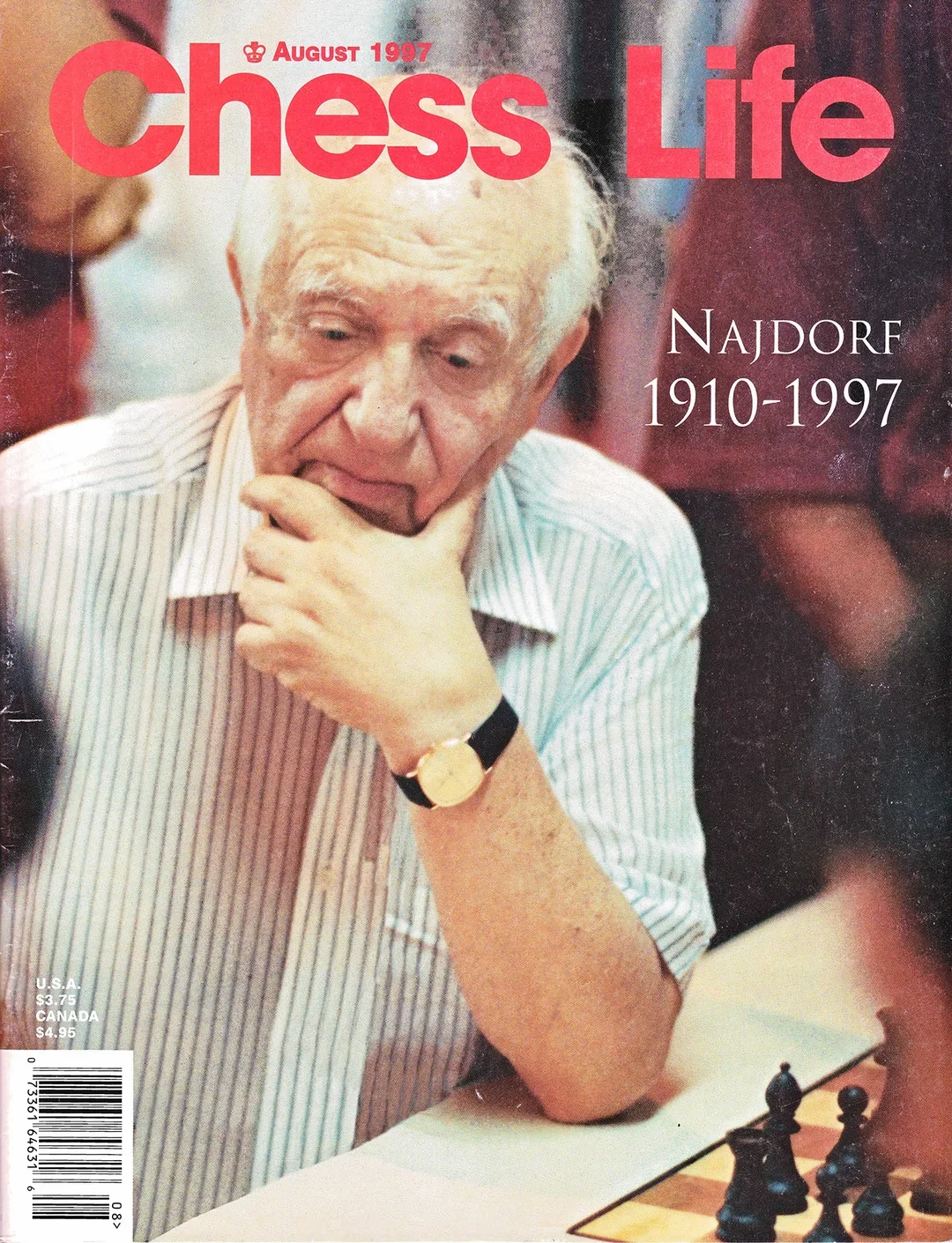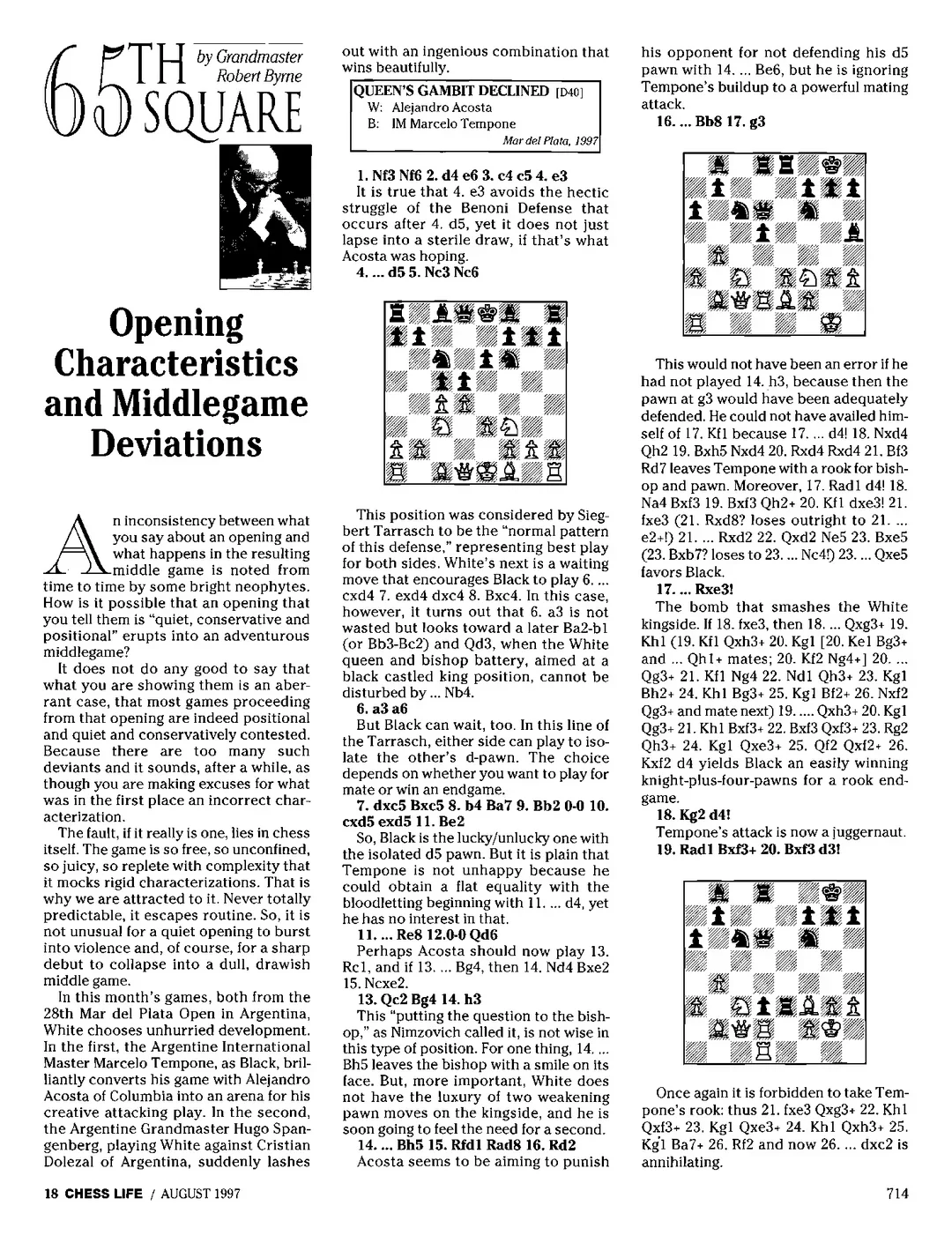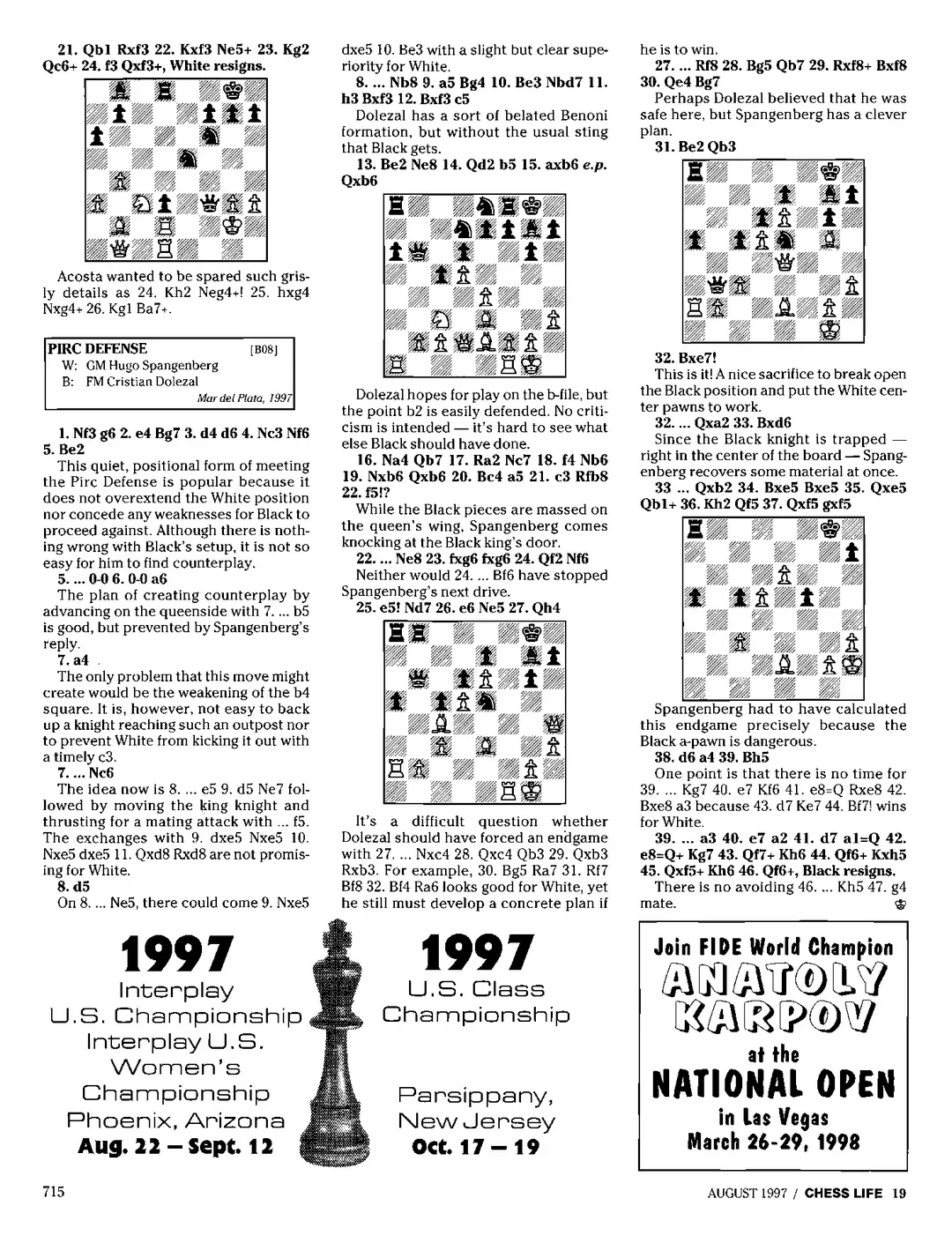Having read Alexander Baburin’s outstanding (and sadly out of print) Winning Pawn Structues, and believing that the IQP is fundamental for chess knowledge and improvement, I’m always on the hunt for interesting games that feature the Isolated Queen’s Pawn. This week’s Throwback Thursday game comes to us from the August 1997 issue of Chess Life, and it’s a worthy addition to any IQP collection.
The August 1997 issue of Chess Life featured a memorial to Miguel Najdorf on its cover, along with the contributions of no less than fifteen columnists. Features included coverage of the 1997 US Amateur Championships, the 18th Annual Lina Grumette Memorial Day Classic, four national events (the Junior Open, US Junior, the G/10, and G/60 Championships) and former Chess Life editor Burt Hochberg’s account of the “Grand Chess” chess variant. It also featured this piece by Grandmaster Robert Byrne, one of the strongest American players of his era and an important chess writer and columnist. Perhaps best known for his 34 years (1972-2006) as the chess columnist for the New York Times – a position that, in a sign of the times, was eliminated in 2014 – Byrne was also a regular in the U.S. Championship and a stalwart member of nine Olympiad teams. An academic philosopher by profession, Byrne was a chess part-timer for many years until the Times column, coupled with the rising tide caused by the Fischer boom, allowed him to “go pro.” Perhaps his greatest achievement came in this era, when he finished third at the 1973 Leningrad Interzonal, qualifying him for the Candidates Matches. There he lost to Boris Spassky, 1.5-4.5. Here are two of Byrne’s finest games. The first, against Bronstein in 1952, was Byrne’s choice for presentation in his final column for the Times. The notes are based on his.
[pgn] [Event "Olympiad-10 Final A"] [Site "Helsinki"] [Date "1952.08.22"] [Round "2"] [White "Bronstein, David Ionovich"] [Black "Byrne, Robert Eugene"] [Result "0-1"] [ECO "D24"] [PlyCount "84"] [EventDate "1952.08.21"] [EventType "team-tourn"] [EventRounds "9"] [EventCountry "FIN"] [SourceTitle "MCD"] [Source "ChessBase"] [SourceDate "1999.07.01"] [SourceVersion "1"] [SourceVersionDate "1999.07.01"] [SourceQuality "1"] [WhiteTeam "Soviet Union"] [BlackTeam "US of America"] [WhiteTeamCountry "URS"] [BlackTeamCountry "USA"] 1. d4 d5 2. c4 dxc4 3. Nf3 Nf6 4. Nc3 a6 (4... e6 5. e4 Be7 6. Bxc4 $16) 5. e4 b5 6. e5 Nd5 7. a4 Nxc3 8. bxc3 Bb7 9. e6 f6 10. g3 (10. Be2 $1) 10... Qd5 11. Bg2 Qxe6+ 12. Be3 c6 (12... Qc8 13. d5) 13. O-O Qc8 14. Re1 Kf7 15. axb5 $6 ( 15. h4 {with the idea 16.Kh2 and 17.Bh3}) 15... axb5 16. Rxa8 Bxa8 17. Qe2 Na6 18. Bf4 g6 19. Nd2 h5 20. h4 Bb7 21. Kh2 Kg7 22. Ra1 Kh7 23. Bh3 Qd8 24. Ne4 Bh6 25. Bxh6 Kxh6 26. Nc5 Nxc5 27. dxc5 Qc7 28. Qd2+ Kg7 29. Rd1 Bc8 30. Bg2 Be6 31. Qe3 Bf7 32. Ra1 Rd8 33. Ra6 Bd5 34. Bxd5 Rxd5 35. Qe6 Re5 (35... Rxc5 $2 36. Ra8 $18) 36. Qh3 (36. Qxc6 Qxc6 37. Rxc6 Kf7 38. Rc8 Ke6 39. c6 Kd6 40. Kg2 Rc5 $19) 36... Rxc5 37. Ra8 Rf5 38. Qf1 Qb7 39. Rd8 Rd5 40. Re8 Qd7 41. Ra8 Rd3 42. Qe1 Rd5 0-1 [/pgn]
The second is an example of Byrne’s ‘mature’ praxis, a lovely win against Smyslov from 1976. [pgn] [Event "Interzonal-10a"] [Site "Biel"] [Date "1976.07.26"] [Round "12"] [White "Byrne, Robert Eugene"] [Black "Smyslov, Vassily V"] [Result "1-0"] [ECO "C19"] [WhiteElo "2540"] [BlackElo "2580"] [PlyCount "73"] [EventDate "1976.07.11"] [EventType "tourn"] [EventRounds "19"] [EventCountry "SUI"] [EventCategory "12"] [SourceTitle "IZT"] [Source "ChessBase"] [SourceDate "1999.07.01"] [SourceVersion "1"] [SourceVersionDate "1999.07.01"] [SourceQuality "1"] 1. e4 e6 2. d4 d5 3. Nc3 Bb4 4. e5 Ne7 5. a3 Bxc3+ 6. bxc3 c5 7. Nf3 Bd7 8. Bd3 c4 9. Bf1 Ba4 10. g3 Qa5 11. Bd2 Nd7 12. Bh3 Nb6 13. O-O Bd7 14. Nh4 Na4 15. f4 Nf5 16. Nxf5 exf5 17. g4 fxg4 18. Bxg4 f5 19. exf6 O-O-O 20. fxg7 Rhg8 21. Kh1 Rxg7 22. Bxd7+ Rdxd7 23. f5 Qd8 24. Qf3 Nb6 25. Bf4 Rdf7 26. Bg3 Qg5 27. Rae1 Qg4 28. Qe3 Re7 29. Qxe7 Rxe7 30. Rxe7 Kd8 31. f6 Nd7 32. Rxd7+ Kxd7 33. f7 Qe4+ 34. Kg1 Qe3+ 35. Kg2 Qe4+ 36. Rf3 Qxc2+ 37. Kh3 1-0 [/pgn]Growing up in New York, and coming to chess in the early 90s, Byrne’s columns in the Times were of great value to me. His was the analysis that led me through the 1990 Kasparov-Karpov match, and for years my grandfather would clip his columns and mail them to me. So it is with no small bit of nostalgia that I present to you Byrne’s analysis of Acosta-Tempone (Mar del Plata, 1997) as it appeared in the August 1997 issue of Chess Life. The analysis is uncorrected, so interested readers may want to try to “find the holes” in Byrne’s notes as a training project.
[pgn] [Event "Mar del Plata op"] [Site "Mar del Plata"] [Date "1997.??.??"] [Round "2"] [White "Acosta, Mariano"] [Black "Tempone, Marcelo"] [Result "0-1"] [ECO "D40"] [WhiteElo "2075"] [BlackElo "2450"] [Annotator "Byrne,R"] [PlyCount "48"] [EventDate "1997.03.??"] [EventType "swiss"] [EventRounds "9"] [EventCountry "ARG"] [SourceTitle "EXT 1998"] [Source "ChessBase"] [SourceDate "1997.11.17"] [SourceVersion "1"] [SourceVersionDate "1997.11.17"] [SourceQuality "1"] 1. Nf3 Nf6 2. d4 e6 3. c4 c5 4. e3 {It is true that 4. e3 avoids the hectic struggle of the Benoni Defense that occurs after 4. d5, yet it does not just lapse into a sterile draw, if that's what Acosta was hoping.} d5 5. Nc3 Nc6 { This position was considered by Siegbert Tarrasch to be the "normal pattern of this defense," representing best play for both sides. White's next is a waiting move that encourages Black to play 6. ... cxd4 7. exd4 dxc4 8. Bxc4. In this case, however, it turns out that 6. a3 is not wasted but looks toward a later Ba2-b1 (or Bb3-Bc2) and Qd3, when the White queen and bishop battery, aimed at a black castled king position, cannot be disturbed by ... Nb4.} 6. a3 a6 {But Black can wait, too. In this line of the Tarrasch, either side can play to isolate the other's d-pawn. The choice depends on whether you want to play for mate or win an endgame.} 7. dxc5 Bxc5 8. b4 Ba7 9. Bb2 O-O 10. cxd5 exd5 11. Be2 {So, Black is the lucky/unlucky one with the isolated d5 pawn. But it is plain that Tempone is not unhappy because he could obtain a flat equality with the bloodletting beginning with 11. ... d4, yet he has no interest in that.} Re8 (11... d4) 12. O-O Qd6 13. Qc2 ({Perhaps Acosta should now play} 13. Rc1 {, and if} Bg4 {then} 14. Nd4 Bxe2 15. Ncxe2 {.}) 13... Bg4 14. h3 {This "putting the question to the bishop," as Nimzovich called it, is not wise in this type of position. For one thing, 14. ... Bh5 leaves the bishop with a smile on its face. But, more important, White does not have the luxury of two weakening pawn moves on the kingside, and he is soon going to feel the need for a second.} Bh5 15. Rfd1 Rad8 16. Rd2 {Acosta seems to be aiming to punish his opponent for not defending his d5 pawn with 14. ... Be6, but he is ignoring Tempone's buildup to a powerful mating attack.} Bb8 17. g3 { This would not have been an error if he had not played 14. h3, because then the pawn at g3 would have been adequately defended.} ({He could not have availed himself of} 17. Kf1 {because} d4 $1 18. Nxd4 Qh2 19. Bxh5 Nxd4 20. Rxd4 Rxd4 21. Bf3 Rd7 {leaves Tempone with a rook for bishop and pawn.}) ({Moreover, } 17. Rad1 d4 $1 18. Na4 Bxf3 19. Bxf3 Qh2+ 20. Kf1 dxe3 $1 21. fxe3 (21. Rxd8 $2 {loses outright to} e2+ $1) 21... Rxd2 22. Qxd2 Ne5 23. Bxe5 (23. Bxb7 $2 Nc4) 23... Qxe5 {favors Black.}) 17... Rxe3 $1 {The bomb that smashes the White kingside.} 18. Kg2 ({If} 18. fxe3 {, then} Qxg3+ 19. Kh1 (19. Kf1 Qxh3+ 20. Kg1 (20. Ke1 Bg3+ {and ... Qh1+ mates}) (20. Kf2 Ng4+) 20... Qg3+ 21. Kf1 Ng4 22. Nd1 Qh3+ 23. Kg1 Bh2+ 24. Kh1 Bg3+ 25. Kg1 Bf2+ 26. Nxf2 Qg3+ {and mate next}) 19... Qxh3+ 20. Kg1 Qg3+ 21. Kh1 Bxf3+ 22. Bxf3 Qxf3+ 23. Rg2 Qh3+ 24. Kg1 Qxe3+ 25. Qf2 Qxf2+ 26. Kxf2 d4 {yields Black an easily winning knight-plus-four-pawns for a rook endgame.}) 18... d4 $1 {Tempone's attack is now a juggernaut.} 19. Rad1 Bxf3+ 20. Bxf3 d3 $1 21. Qb1 {Once again it is forbidden to take Tempone's rook.} ({Thus,} 21. fxe3 Qxg3+ 22. Kh1 Qxf3+ 23. Kg1 Qxe3+ 24. Kh1 Qxh3+ 25. Kg1 Ba7+ 26. Rf2 {and now} dxc2 {is annihilating.}) 21... Rxf3 22. Kxf3 Ne5+ 23. Kg2 Qc6+ 24. f3 Qxf3+ ({Acosta wanted to be spared such grisly details as} 24... Qxf3+ 25. Kh2 Neg4+ 26. hxg4 Nxg4+ 27. Kg1 Ba7+) 0-1 [/pgn]
Categories
Archives
- December 2025 (19)
- November 2025 (29)
- October 2025 (39)
- September 2025 (27)
- August 2025 (29)
- July 2025 (43)
- June 2025 (25)
- May 2025 (24)
- April 2025 (29)
- March 2025 (29)
- February 2025 (20)
- January 2025 (24)
- December 2024 (34)
- November 2024 (18)
- October 2024 (35)
- September 2024 (23)
- August 2024 (27)
- July 2024 (44)
- June 2024 (27)
- May 2024 (31)
- April 2024 (51)
- March 2024 (34)
- February 2024 (25)
- January 2024 (26)
- December 2023 (29)
- November 2023 (26)
- October 2023 (37)
- September 2023 (27)
- August 2023 (37)
- July 2023 (47)
- June 2023 (33)
- May 2023 (37)
- April 2023 (45)
- March 2023 (37)
- February 2023 (28)
- January 2023 (31)
- December 2022 (23)
- November 2022 (32)
- October 2022 (31)
- September 2022 (19)
- August 2022 (39)
- July 2022 (32)
- June 2022 (35)
- May 2022 (21)
- April 2022 (31)
- March 2022 (33)
- February 2022 (21)
- January 2022 (27)
- December 2021 (36)
- November 2021 (34)
- October 2021 (25)
- September 2021 (25)
- August 2021 (41)
- July 2021 (36)
- June 2021 (29)
- May 2021 (29)
- April 2021 (31)
- March 2021 (33)
- February 2021 (28)
- January 2021 (29)
- December 2020 (38)
- November 2020 (40)
- October 2020 (41)
- September 2020 (35)
- August 2020 (38)
- July 2020 (36)
- June 2020 (46)
- May 2020 (42)
- April 2020 (37)
- March 2020 (60)
- February 2020 (38)
- January 2020 (45)
- December 2019 (34)
- November 2019 (35)
- October 2019 (42)
- September 2019 (45)
- August 2019 (56)
- July 2019 (44)
- June 2019 (35)
- May 2019 (40)
- April 2019 (48)
- March 2019 (61)
- February 2019 (39)
- January 2019 (30)
- December 2018 (29)
- November 2018 (51)
- October 2018 (45)
- September 2018 (29)
- August 2018 (49)
- July 2018 (35)
- June 2018 (31)
- May 2018 (39)
- April 2018 (31)
- March 2018 (26)
- February 2018 (33)
- January 2018 (30)
- December 2017 (26)
- November 2017 (24)
- October 2017 (30)
- September 2017 (30)
- August 2017 (31)
- July 2017 (28)
- June 2017 (32)
- May 2017 (26)
- April 2017 (37)
- March 2017 (28)
- February 2017 (30)
- January 2017 (27)
- December 2016 (29)
- November 2016 (24)
- October 2016 (32)
- September 2016 (31)
- August 2016 (27)
- July 2016 (24)
- June 2016 (26)
- May 2016 (19)
- April 2016 (30)
- March 2016 (36)
- February 2016 (28)
- January 2016 (32)
- December 2015 (26)
- November 2015 (23)
- October 2015 (16)
- September 2015 (28)
- August 2015 (28)
- July 2015 (6)
- June 2015 (1)
- May 2015 (2)
- April 2015 (1)
- February 2015 (3)
- January 2015 (1)
- December 2014 (1)
- July 2010 (1)
- October 1991 (1)
- August 1989 (1)
- January 1988 (1)
- December 1983 (1)










